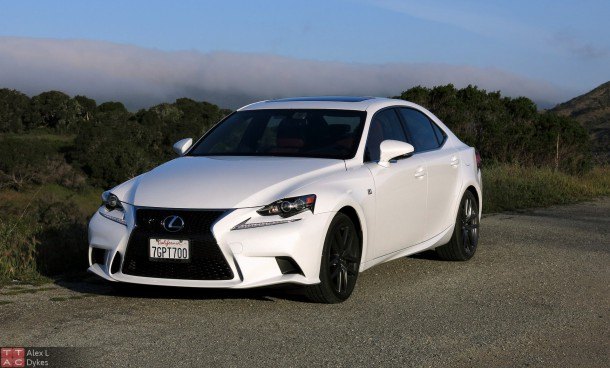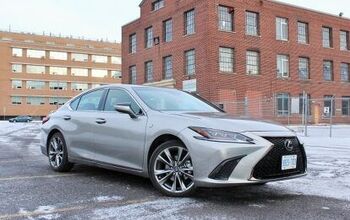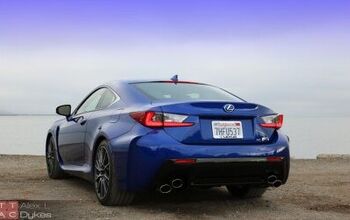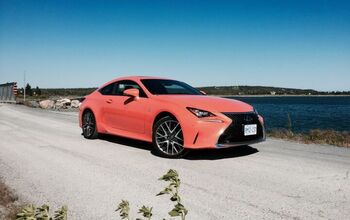2015 Lexus IS 350 F Sport Review (With Video)

BMW moved over 140,000 3-Series’ last year in America. They didn’t do this by being the most luxurious option or by being the best handling option. (The truth is hard to hear, I’m sorry.) Instead, BMW did this by doing exactly what shoppers asked for; luxury car buyers want a comfy ride with a luxury logo on the front, good fuel economy and to read reviews that extol the track-day virtues of their car of choice. The average buyer will never be on a track, but it’s critical to know your car belongs there.
What BMW dealers don’t want you to know: there are two sedans in this segment that are arguably better on the track than a 328i or 335i and we’re talking about one of them today, the IS 350 F Sport.
Exterior
Lexus’ exterior styling used to strike me as graceful, sophisticated and reserved. Apparently, however, the front end got no respect on the Autobahn, so the F Sport nose was created. While I can’t say if it commands more respect in Germany, the ginormous grille on our IS 350 F Sport looked ready to devour small children and subcompact cars alike. While some folks have said they dislike the gaping maw, I actually like it. What I’m not a fan of are the separate headlamp and “Nike-swoosh” daytime running lamp modules; I find the look a little discordant. Whether you like it or not, you have to admit this front end is more dramatic than anything on offer from BMW, Mercedes, Audi or Infiniti.
SUBSCRIBE: To the TTAC YouTube Channel Here
Out back, less has changed, with the rear being more reserved than the front. But it’s the side profile where things really divert. The IS is 3.5 inches longer than the last generation model and most of the increase goes to the rear seat area – although, some of it also goes to the trunk, making the IS look more balanced than before. Thanks to pedestrian impact regulations in Europe, the front end has become blunter (just as we have seen from the Europeans lately), which actually helps the front 3/4 view. I think the Cadillac ATS is the most attractive sedan in this segment, but the IS in F Sport trim leaps up the scale to number 3, just behind the ATS and 3-Series.
Interior
While BMW and Audi have opted for an open and expansive interior theme, the IS feels tight and close to the driver by design with a high beltline and tall center console. F Sport models get a configurable LCD disco dash instead of the white-on-black gauges we normally expect from the brand. Similar to Volvo’s new LCD instrument cluster, the display can seem a little lost in the binnacle as the binnacle normally houses a wider traditional dial cluster. Since Cadillac has yet to move their large LCD instrument cluster down-market to the ATS, there really isn’t any competition for this display at the moment.
As you’d expect from Lexus, one can still get acres of stained wood and soft leather, but neither are standard. Like most entries in this segment, leather is reserved for specific packages and wood is an optional upgrade. Front seat comfort proved excellent during my week. The sport seats easily bested the Audi A4, Cadillac ATS and the base seats in the BMW 328i or Mercedes C300. Wider folks should know that the bolstering is pronounced and the F Sport trim doesn’t have an option to delete the sport seats.
Thanks to the wheelbase stretch, combined legroom is up by 2.6 inches inside which places the IS towards the top of the group in total legrooom. Nobody expected the BMW 3-Series to grow as much as it did in its latest incarnation, which becomes quite obvious when you run the numbers. The 3-Series boasts the second best legroom figures behind the much larger Infiniti Q50. The Lexus offers a slightly larger trunk, but I found the overall trunk dimensions to be more advantageous in the BMW.
Infotainment
The 2014 redesign of the IS brought a raft of new features from traffic maps on non-navigation equipped models to predictive traffic, improved voice recognition and smartphone integration. Alas, the lord giveth and he taketh away. Along with the new software comes Lexus’ Remote Touch input device, or as I prefer to call it: the Lexus joystick. I find little joy in the mouse-like controller, but it is better than the trackpad you find in the NX. The controller is the textbook example of the difference between an intuitive input method and one that is optimized for use in a car. The joystick is intuitive, it’s just not well suited to a vehicle as it requires much more eye-off-the-road time. I grabbed a few friends and had them perform a few identical functions in the Lexus and a BMW with iDrive while I watched their eyes. It simply takes longer for you to find what you need in the Lexus system. Oddly enough, the same Lexus software without a touchscreen is one of the least distracting available, but you can only get that in the GX and LX. If you don’t buy navigation, you still get the 7-inch screen but trade the joystick for a rotary knob.
Lexus doesn’t offer any sort of heads-up display a la BMW, but you can gadgets like radar cruise control, Mark Levinson branded audio system, blind spot monitoring and lane departure warning.
Engine
Standing somewhat alone in this segment is a 100-percent naturally-aspirated engine lineup. While everyone but Infiniti has moved to a turbo four to fill the bottom end, Lexus has stuck with their tiny V6. (I’m not counting the 2.5-liter four-banger in the base ATS. Why? Who would?) Displacing 2.5 liters and sporting direct injection, the IS 250 is good for 204 ponies and 185 lb-ft of torque. [It’s the least powerful V6 currently on sale. -Ed] While many in the industry would once have complained about a base luxury model without an inline-6 engine, this V6 now competes with four-cylinder engines. Although a V6 isn’t as balanced as an I6, it’s miles ahead of an I4. The model we tested is the 3.5-liter V6 IS 350. Adding a liter bumps power to 306 and torque to 277. For reasons known only to Lexus’ product planning team, the 220 horsepower IS 300h remains forbidden fruit on our shores.
Lexus tends to be a cautious company when it comes to adopting new technology and, as a result, the 2.5-liter V6 and AWD models of the 3.5-liter have to make do with ye olde 6-speed automatic from Aisin. If you get the RWD version of the IS 350 that we tested, you get Aisin’s new 8-speed auto, a variant of the transmission used in the Corvette and select Cadillacs.
Drive
The naturally aspirated engine lineup is the first thing you will notice about the IS out on the road. Much like the 3.6-liter V6 in the ATS and the 3.7-liter V6 in the Q50, power builds in a linear fashion. This is quite different from the C400, 335i and other turbo entries which typically have torque and horsepower “plateaus” with sharp drops on either end. 0-60 acceleration in our F Sport tester came in at 5.6 seconds – not a bad time by any stretch. However, Volvo’s front-wheel-drive S60 T6 Drive-e will do the same sprint in 5.4. The purist in me prefers the feel and unadulterated sound a naturally-aspirated engine delivers, but the pragmatist in me realizes the C400, 335i, S4 and S60 T6 will all beat the IS to the freeway ramp. Opting for Lexus’ AWD system improves grip, but the loss of two gears causes the 0-60 time to stretch to 5.7 seconds, getting close to the less powerful BMW 328xi. AWD shoppers also have to live with an odd hump in the front foot-well caused by the transfer case and driveshaft to the front axle.
The responsiveness of the IS in tight corners demonstrates how much time Lexus spent engineering the suspension. The old IS came across as isolated, perhaps even sloppy, while this chassis is sharp and crisp. Every system feels like a team player, from the suspension to the transmission shift logic and the revised double-wishbones up front. The IS quite simply delivers the best feel in the corners and out on the track with every system tuned to near perfection. (Bear in mind we still have electric power steering, so it’s all relative.) The IS actually manages to feel a hair more precise, although not as engaging, than the E90 3-Series (previous generation). The F30 (current generation) has traded handling prowess for a softer ride and a ginormous back seat. And therein lies the rub: the change has improved BMW’s sales rather than stopping the gravy train. Meanwhile, the Audi and Volvo plow like a John Deere when they encounter a corner and the Mercedes feels just as you would expect – heavy and soft. The purist in me prefers the crisp handling and impeccable feel of the IS on a track. The pragmatist in me is keenly aware that feel doesn’t actually get you around a track. That’s where power comes in. Because of the power deficit, the 335i, S60 T6 AWD, C400 and S4 are all faster around your average track. If you’re talking autocross, the IS has a chance, but even the Volvo will beat it around Laguna Seca.
Competition
Comparing the IS 350 with the 335i seems like the natural thing to do – after all, they both have “3” in the model number – but a more apt comparison is the 328i. The IS 350 slots between the 328i and the 335i in both price and performance, but price is critical. Meanwhile IS 250 performs more like the 320i than the 328i.
The IS 350 F Sport manages to be a hair less than a comparably equipped 328i M-Sport, which is an excellent start. Despite costing a fraction less, the Lexus delivers considerably more refinement under the hood, better acceleration and more driving feel in the twisties. Our F Sport was notably less expensive than a Mercedes C300, and even when you add AWD to the Lexus, it’s still the more willing partner on your favorite mountain highway.
Audi’s A4 ends up being around the same price as the IS 350 while Volvo’s S60 is the discount option. Both the Audi and the Volvo start as FWD vehicles but add AWD to compensate for their front heavy designs. Unless you step up to the considerably more expensive S4, the Audi comes across as underpowered and all versions of the A4 feel nose heavy in comparison. The Volvo has a similar weight issue up front but the Swedes will happily drop a powerful turbo engine under the hood, mate it to AWD and sell it for less than the Lexus. The resulting S60 R-Design will out-pace the IS 350 F Sport but the experience will be much different. The Volvo will be understeering like mad in the corners; the IS will feel balanced and poised. Unfortunately, the Lexus’ driver will have to enjoy the feel while looking at the S60’s tail lamps.
The Infiniti Q50 is the often forgotten competitor. Nissan’s luxury arm has never quite reached the same status as Lexus as far as brand perception – perhaps that’s why. Never the less, the Infiniti has good looks and a low price tag on its side. Even the $37,150 base model starts with a 328 horsepower 3.7-liter V6. It’s still slower than BMW’s 335i, but at 5.2 seconds to 60, it is among the faster options. If you want more power and better economy, Infiniti will sell you their hybrid version that scoots to highway speed in 4.9. Comparably equipped, the Q50 is about $2,000 less than the F Sport we tested, making it the best RWD deal in this segment.
After a week with the IS 350, I’ll admit I was torn. The way the IS drives and feels on my mountain road commute is incredible. The way the IS feels on a track is alluring. And the value proposition is undeniable. Lexus’ well deserved reliability reputation and generally lower operating costs means the IS will cost less to own. All these things should mean my purist and pragmatic boxes will be well and truly checked. The Lexus has the luxury and track-day-diary cred to compete with the competition, but the infotainment system in the IS and slower 0-60 time keep the Lexus from being my choice in this segment. If my money were on the line, I’d live with Infiniti’s questionable steer-by-wire system and get the Q50S hybrid instead. You get more room inside, a 0-60 time matching the 335i and 31 MPG. While the IS 350 F Sport represents a good value against BMW’s volume 3-Series model, they still have nothing to compete properly with the 335i. Yes, the IS 350 F Sport feels better and road holds better than a comparably equipped 335i. But, as BMW has recently shown, perhaps going around a corner perfectly isn’t all that important after all.
Lexus provided the vehicle, insurance and one tank of gas for this review
Specifications as tested
0-30: 2.2 Seconds
0-60: 5.6 Seconds
1/4 Mile: 14.8 Seconds at 100 MPH
Average Observed Economy: 20 MPG over 674 miles

More by Alex L. Dykes
Latest Car Reviews
Read moreLatest Product Reviews
Read moreRecent Comments
- Ajla "Like showroom" is a lame description but he seems negotiable on the price and at least from what the two pictures show I've dealt with worse. But, I'm not interested in something with the Devil's configuration.
- Tassos Jong-iL I really like the C-Class, it reminds me of some trips to Russia to visit Dear Friend VladdyPoo.
- ToolGuy New Hampshire
- TheEndlessEnigma TTAC just jumped the shark.
- Peter Alaska. You got a long straight away. Lots of curves, and 2 hairpin turns in the south.






































































Comments
Join the conversation
Did driving the car make you angry at railroad crossings?
Such a great looking car. I wonder why Lexus opted to not have the IIHS test small frontal overlap crashes in the new version of this car. The previous generation car had poor ratings in those types of crashes according to the IIHS. I also read on the IIHS website that 10,000 people die each year in those types of crashes. I won't buy a car that doesn't protect me well in that type of wreck. I called the IIHS and asked why the new version of the IS wasn't tested for small frontal overlap and they said it was because Lexus did not want the test. I wonder if Lexus knows these cars don't do well still and they don't want public confirmation of it. I will have to keep my Honda Accord for now since it does great in that type of car wreck.